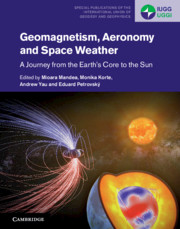Book contents
- Geomagnetism, Aeronomy and Space Weather
- Special Publications of the International Union of Geodesy and Geophysics Series
- Geomagnetism, Aeronomy and Space Weather
- Copyright page
- Contents
- Contributors
- Preface
- Part I Introduction
- Part II Geomagnetic Field
- Part III Spatial and Temporal Variations of the Geomagnetic Field
- 9 Spatial and Temporal Changes of the Geomagnetic Field
- 10 The Global Lithospheric Magnetic Field
- 11 The Ionospheric Field
- 12 The Magnetosphere
- 13 Temporal Field Variations
- Part IV Space Weather
- Part V Magnetic Fields beyond the Earth and beyond Today
- Index
- References
13 - Temporal Field Variations
from Part III - Spatial and Temporal Variations of the Geomagnetic Field
Published online by Cambridge University Press: 25 October 2019
- Geomagnetism, Aeronomy and Space Weather
- Special Publications of the International Union of Geodesy and Geophysics Series
- Geomagnetism, Aeronomy and Space Weather
- Copyright page
- Contents
- Contributors
- Preface
- Part I Introduction
- Part II Geomagnetic Field
- Part III Spatial and Temporal Variations of the Geomagnetic Field
- 9 Spatial and Temporal Changes of the Geomagnetic Field
- 10 The Global Lithospheric Magnetic Field
- 11 The Ionospheric Field
- 12 The Magnetosphere
- 13 Temporal Field Variations
- Part IV Space Weather
- Part V Magnetic Fields beyond the Earth and beyond Today
- Index
- References
Summary
The geomagnetic field supports a wide range of magnitudes, spatial scales and temporal variations. Outlined here are particular recent advances in temporal variability, stretching from geomagnetic field polarity reversals over millions of years, through secular field variations and ultra-low frequency (ULF) waves (1mHz – 5Hz), to very low frequency(VLF) emissions with frequencies in the kHz range. Long-term variations are discussed with respect to paleomagnetic, geological and archaeological records. Both external and internal fields contribute to temporal variations on decadal to daily time scales. More rapid oscillations at ULF wave frequencies associated with Sun-Earth connection contribute to weather in space. These involve the magnetosphere, ionosphere and atmosphere system, and may affect charged/neutral particle populations. Waves are generated external and internal to the magnetosphere and through integration of global magneto-hydrodynamic or local magneto-ionic modelling with satellite and ground observations, progress has been made in understanding the dynamics of waves and energy transfer within the coupled system. Equally important to space weather is the understanding of ULF and VLF waves on energetic charged particles in the Van Allen radiation belts during geomagnetic storms.
Keywords
- Type
- Chapter
- Information
- Geomagnetism, Aeronomy and Space WeatherA Journey from the Earth's Core to the Sun, pp. 181 - 206Publisher: Cambridge University PressPrint publication year: 2019



